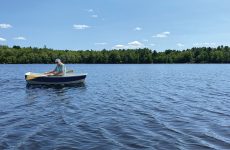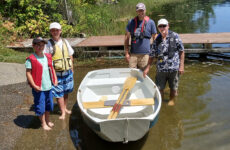January/February 2022
By Clint Chase
Thank you to everyone who responded to the Pram survey. It is exciting to do this project with Points East involved and a bit of an audience. One of the challenges I have as a designer of boats and kits is knowing if the final product will be of enough interest to justify the significant investment in time towards a design project. From the looks of it, even if a few of you partake, it will be worthwhile from a business point-of-view and also very satisfying to see a boat get on the water, used, tested and enjoyed by people. I am excited that you, the readership of Points East, are an experienced group of people who know about being on the water and what makes a good dinghy.
I had drawings of prams that I had built, considered making into kits, and sketches of new prams that I conceptualized. I ended up pulling up the lines of an existing design and reworking them to look like my sketches. I wasn’t hugely surprised by the results, but they were still very helpful in focusing the design. The building method for the boat was somewhat a fixed requirement from my end: the system uses a cedar chine log where the bottom and sides come together (in lieu of a structural fiberglass layup) and a system I developed for my other kits called “Tab-n-Lock.” In this method, tabs on the frames and bulkheads stick into matching slots in the planks – a sort of mortise & tenon system – and makes the build go very slick.
Seeking stability
To make the wood-chine, Tab-n-Lock system work well, I had a flat bottom sketched. Still, it was much narrower than we would need to satisfy one of the most unequivocal results of the survey: the dinghy would have to be very stable (over 85% put it as a high priority and essential). To be stable, a “wide-ish” flat bottom would be needed, as will the right amount of flare in the first plank, called the garboard. The garboard would also need to have a certain angle to work with the construction method. So, I widened the bottom a fair bit overall, but I also widened it forward a bit because people want to row to the beach and step over the bow easily with the bottom up on the beach – which will be an important use judging from the results. We will need to figure out how to really protect the bottom for landings, too.
I was surprised and delighted that most people did not care a lot about motoring, that they would row the boat primarily. One person wanted to put a motor on it exclusively, and the rest had it as a low priority. Over 70% of respondents gave rowing a high priority. I did try to keep the transom angle and width appropriate for a small (2.5hp) motor should someone need to rig one up. Yet, with rowing being so important, I needed to keep the transom out of the water and not too wide! You will see that the waterline is just below transom height. So, when loaded to the waterline, the bottom of the transom will not drag when rowing.
Calculating capacity
This brings us to the waterline. Prams are great because they have a lot of capacity for their length. Most people wanted a boat with medium or higher capacity, but the results weren’t as strong as they were for stability and rowing. This is good because to get huge capacity, the rowing suffers! So how much capacity is enough? Right now, the boat displaces 275 lbs. at the waterline, and the PPI is 90 lbs. That means that with the weight of the boat (I estimate she won’t be more than 65 lbs.) plus people. . . when that totals 275 lbs, the boat will sit at the waterline drawn in the renderings. In this state, the stern transom just clears the water for good rowing, and the bow transom is well out of the water, so it shouldn’t “plow” into a choppy sea state, something I have experienced with prams. PPI is “pounds-per-inch-immersion”: with an additional 90 lbs. the boat will press into the water 1” deeper, and you will lose 1” of freeboard.
Getting the hull shape right
A few other notes: towability reigned supreme in the results. This one is fairly easy to handle as long as the bow transom is well out of the water, the boat is light, and the skeg helps it track well in towing mode. I think the wider bottom width will make it slide across the top of the water just fine. Several folks want a nesting dinghy. This will be a new venture for me, and I intend to figure that one out. The first item is to get the hull shape right, then design the kit with the middle bulkhead of the boat being a separation plane so the boat can come apart. Some want to sail, and that will be no problem; a small lug sail or sprit sail will be drawn for the boat, a rig that can easily fit inside the boat. One question I have is: how to handle oar stowage? A boat with 45” of beam will take 7-7’3” oars, but that length will not fit inside the boat. To lay on the seats in the ends of the boat, the oars would have to be no more than 6’8”, which would be OK for utility but not great for pleasure rowing.
Interior flexibility
Another huge question at this point is interior layout. By default, I always figure enclosed plywood flotation tanks in the ends. I don’t want the forward bulkhead to be too far aft because it makes it harder to step out of the boat when beached, and we also want a wide enough seat there for sitting. The aft seat is large enough to store some safety supplies and make a good seat. But for a tall guy like me, when at oars, that aft tank may make me bend my knees too much for rowing. . . hard to say. One key requirement about the interior is adjustability. It is really nice when taking on passengers to be able to shift around. The middle rower shifts to the forward seat and rows from there when taking one person but stays in place when taking on two people. I am playing with using seat risers – bent pieces of wood – to support the middle seat, which can move fore and aft a bit. But seat risers are also super useful for tying in gear and lashing to. The other trick some pram designers have used is a fore/aft seat that the rower slides along to adjust trim for different passenger and gear scenarios.
For now, I like the aesthetics of the boat – that is very important. The length drawn is 7-feet, but I intend to scale the boat and have a couple of different length options – perhaps down to 6’6” as one has requested and up to 8’, a common dinghy size. However, 7-feet is a nice option, and we can use that as the basis as we finish up the hull shape and move onto the interior layout. I welcome thoughts, comments, and suggestions. As you can see, a lot of this is subjective work, but there are hard numbers involved, too, and tradeoffs. For instance, one trade-off is the flat bottom: I know some will want a “V.” But to get the simple construction we need – 80% of folks want to build their own Points East Pram – the flat bottom is best (it also really helps with stability and capacity).
Ideas about hull shape, as well as the ideal length are welcome at this point, as are getting into some specifics about the interior. Other aspects like armoring the bottom or the nesting are also open game at this point. With your help, I look forward to working more on this beautiful little pram and watching it come together!
Clint Chase is the owner of Chase Small Craft, a builder of boats and boat kits in Saco, Maine. He is collaborating with Points East to design and develop a pram-style dinghy that can be used as a tender. We will be posting updates on the project in the magazine and on our website at pointseast.com/pram.









 We have complete issues archived to 2009. You can read them for free by following this link.
We have complete issues archived to 2009. You can read them for free by following this link.